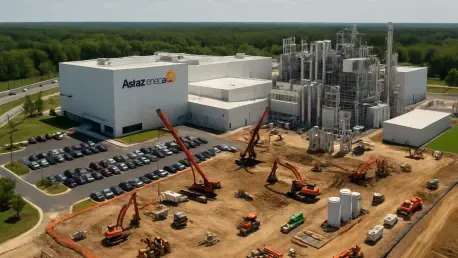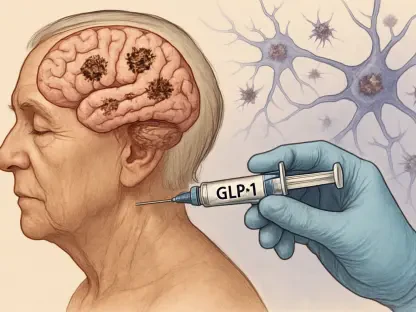In an era where supply chain resilience and access to life-saving therapies dominate healthcare discussions, AstraZeneca’s announcement of a $2 billion investment in Maryland facilities has captured significant attention, raising critical questions about domestic production. This ambitious expansion, targeting enhanced biologics and rare disease manufacturing, also prompts inquiries into economic impact and technological innovation in the US biopharmaceutical sector. How will this move shape the industry, and what do stakeholders think about its broader implications? This roundup gathers diverse perspectives, tips, and analyses from industry voices to explore the multifaceted impact of this landmark project, offering a comprehensive look at its potential to transform healthcare and local economies.
Unpacking the Strategic Vision Behind the Maryland Investment
Industry Perspectives on Bolstering Biologics Capacity in Frederick
The plan to nearly double commercial manufacturing capacity at the Frederick site by 2029 has sparked enthusiasm among biopharma analysts for its focus on biologics and rare disease therapies. Many industry observers highlight that scaling domestic production addresses a long-standing vulnerability in relying on overseas supply chains, especially for complex medicines. This shift is seen as a proactive step to ensure consistent access to critical drugs amid global disruptions.
Contrasting views emerge on the challenges of such an expansion, with some stakeholders pointing to the intricate nature of biologics production. Concerns include the high costs of scaling and the need for specialized infrastructure, which could strain budgets if demand projections falter. Others argue that the long-term security of localized manufacturing outweighs initial financial burdens, positioning the US as a leader in this high-value sector.
A recurring tip from manufacturing consultants is for companies to prioritize modular facility designs during expansions like this one. Such flexibility allows for quicker adaptation to evolving therapeutic needs or regulatory changes, ensuring sustained output. This advice underscores a broader consensus that strategic planning is essential to balance ambition with practicality in projects of this magnitude.
Clinical Research Breakthroughs at Gaithersburg: What Experts Say
The new clinical manufacturing facility in Gaithersburg, set to support early-stage drug development by 2029, has drawn praise for its potential to accelerate clinical trial timelines. Many in the research community note that having a dedicated site for producing molecules for trials can significantly shorten the path from lab to patient, especially for rare disease treatments. This synergy with Frederick’s commercial focus is viewed as a holistic approach to drug development.
However, opinions differ on the hurdles of establishing such a facility, with some cautioning about the high initial investments and potential regulatory delays. A segment of industry watchers suggests that while the intent is commendable, unforeseen compliance issues could slow progress, impacting timelines for new therapies. This perspective emphasizes the importance of preemptive collaboration with regulatory bodies to streamline approvals.
Practical advice from clinical research professionals centers on integrating robust data systems early in facility planning. Leveraging real-time analytics can enhance process optimization and ensure quality during trial phases, a strategy seen as vital for maintaining momentum. This tip reflects a shared belief that technological preparedness is key to maximizing the facility’s impact on therapy development.
Technology Integration: Innovation or Risk?
The incorporation of automation, data analytics, and AI into both Maryland facilities has ignited discussions about the future of biomanufacturing. Many tech-focused analysts commend this move as a necessary alignment with industry trends toward next-generation production platforms, which promise greater efficiency and reliability. They argue that such advancements position AstraZeneca as a frontrunner in meeting the demands of complex biologics.
On the flip side, skepticism exists about over-reliance on cutting-edge tools, with some industry voices questioning whether workforce readiness and regulatory frameworks can keep pace with rapid innovation. There’s a concern that technological hiccups or skill gaps could disrupt operations if not addressed proactively. This viewpoint calls for a balanced approach to tech adoption, ensuring human expertise remains central.
A common recommendation from tech consultants is to invest in continuous training programs alongside automation rollouts. Equipping staff with skills to manage and troubleshoot advanced systems can mitigate risks of downtime or errors, a strategy seen as critical for seamless integration. This insight highlights the need for a people-centric focus even in tech-driven transformations.
Economic and Community Impact: A Mixed Bag of Opinions
The economic ripple effects of supporting 2,600 jobs across construction, skilled roles, and retained positions have been widely celebrated by local and industry stakeholders. Many economic analysts view this as a significant boost for Maryland, potentially elevating its status as a biopharma hub and attracting further investments. Comparisons to other regional clusters suggest that such projects can catalyze long-term growth in surrounding areas.
Divergent opinions surface regarding the sustainability of this impact, with some pointing to challenges like workforce training and infrastructure strain. Critics note that without adequate support for upskilling local talent or upgrading roads and utilities, the benefits might be short-lived. This perspective urges a closer look at how job creation aligns with community preparedness to handle rapid growth.
Tips from regional development experts include fostering public-private partnerships to address infrastructure needs concurrently with industrial expansion. Such collaborations can ensure that local systems keep up with increased activity, maximizing economic gains. This advice reflects a broader agreement that community integration is as crucial as corporate investment in driving lasting prosperity.
Key Takeaways from Diverse Stakeholder Insights
Synthesizing the varied perspectives, several key themes emerge around this major investment in Maryland. The doubling of biologics capacity, advancements in clinical research, and substantial job growth stand out as transformative elements, aligning with national goals for supply chain resilience. While optimism abounds, concerns about scaling costs, regulatory delays, and tech integration highlight the need for cautious, strategic execution.
For industry players, actionable strategies include investing in localized production models to mirror this approach, as well as adopting advanced technologies with a focus on workforce training. Staying competitive in biopharma increasingly demands a blend of innovation and adaptability, a lesson underscored by the diverse opinions on this expansion. Stakeholders are encouraged to monitor how these facilities evolve as benchmarks for future projects.
Reflecting on the Broader Implications
Looking back, the discourse surrounding AstraZeneca’s $2 billion commitment in Maryland revealed a complex interplay of opportunity and challenge, as voiced by numerous industry perspectives. The enthusiasm for enhanced biologics production and economic growth was tempered by valid concerns over costs, readiness, and sustainability. These discussions painted a picture of an industry at a pivotal juncture, striving for self-reliance while navigating intricate hurdles.
Moving forward, stakeholders should consider deeper investments in workforce development and regulatory alignment to support similar initiatives. Exploring partnerships with local governments and educational institutions could address skill gaps, ensuring communities benefit long-term. Additionally, keeping abreast of policy shifts in biopharma manufacturing will be crucial for anticipating and adapting to changes in this dynamic landscape.









